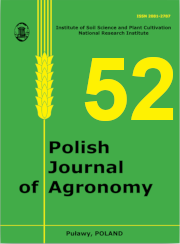Evaluation of methods for determining the LS index at different resolutions for soil erosion modeling using the RUSLE method
##plugins.themes.bootstrap3.article.main##
Abstrakt
This paper investigates the impact of Digital TerrainModel (DTM) resolution on the calculation of the sediment transportcapacity coefficient LS within the Bystra catchment, employingvarious methods through GIS software. The study focuses onthe significant role of GIS in environmental research and processmodeling, emphasizing the relevance of LS coefficient analysis inmorphometry, hydrology, and geomorphology, particularly in thecontext of agricultural soil erosion.The study presents results from calculating the sediment transportcapacity factor LS using three methods for different resolutions(1, 5, 10, 30, 90 meters). LS coefficient determination relies onthe catchment area map and slope map, the latter determined usingtwo methods. The catchment area considered is that of the BystraRiver, a right tributary of the Vistula, flowing through Nałęczów,Wąwolnica, Celejów, Bochotnica in the Lublin Province.Upon determining the LS coefficient, variations in results areobserved, dependent on the chosen method. The discussion sectionhighlights differences in LS coefficient maps based on resolutionand method, with notable distinctions in the north-westernpart for a 10-meter resolution.Analyzing LS coefficient maps at different resolutions, thestudy observes variations in results based on the method employed.Higher LS coefficient values are noted in the river channelfor a 1-meter resolution, attributed to factors such as river bedstructure, building rocks, terrain slope, and climate.The conclusions emphasize the use of specific methods fordetermining slope rasters and highlight the Desmet and Goversmethod as yielding smaller variances in LS coefficient determinationcompared to other methods. The study recommends DTMmodels with resolutions of 1, 5, and 10 meters for LS modeling,considering their beneficial influence on variance and resolution.In summary, this paper contributes valuable insights into theinfluence of DTM resolution on LS coefficient calculations, providinga nuanced understanding of the interplay between methods,resolution, and terrain characteristics in the context of sedimenttransport capacity.
##plugins.themes.bootstrap3.article.details##

Utwór dostępny jest na licencji Creative Commons Uznanie autorstwa – Na tych samych warunkach 4.0 Miedzynarodowe.
Autor udziela redakcji czasopisma Polish Journal of Agronomy (w skrócie: PJA) licencji niewyłącznej i nieodpłatnej na korzystanie z autorskich praw majątkowych do wersji papierowej/drukowanej i elektronicznej utworu Autora opublikowanego w PJA w kraju i za granicą, w całości lub w dowolnej części, w tym umieszczanie utworu w elektronicznych bazach/zbiorach danych lokalnych lub dostępnych w Internecie, przez czas nieograniczony na polach eksploatacji określonych w art. 50 ustawy o prawie autorskim i prawach pokrewnych.
Prace wydane w Polish Journal of Agronomy są udostępniane na licencji Creative Commons Uznanie autorstwa-Na tych samych warunkach 4.0 (CC-BY-SA).

